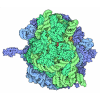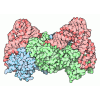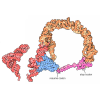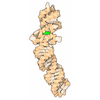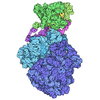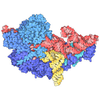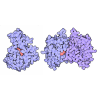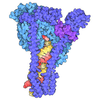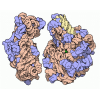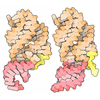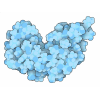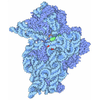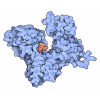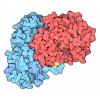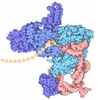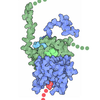+ Open data
Open data
- Basic information
Basic information
| Entry | Database: PDB / ID: 9ec8 | ||||||
|---|---|---|---|---|---|---|---|
| Title | Active state of wild-type EsCas13d ternary complex | ||||||
 Components Components |
| ||||||
 Keywords Keywords | RNA BINDING PROTEIN/RNA / Cas13 / CRISPR / HEPN / RNA nuclease / RNA BINDING PROTEIN-RNA complex | ||||||
| Function / homology | RNA / RNA (> 10) / Uncharacterized protein Function and homology information Function and homology information | ||||||
| Biological species |  [Eubacterium] siraeum DSM 15702 (bacteria) [Eubacterium] siraeum DSM 15702 (bacteria) | ||||||
| Method | ELECTRON MICROSCOPY / single particle reconstruction / cryo EM / Resolution: 3.07 Å | ||||||
 Authors Authors | Chou, C.W. / Finkelstein, I.J. | ||||||
| Funding support |  United States, 1items United States, 1items
| ||||||
 Citation Citation |  Journal: Nat Commun / Year: 2024 Journal: Nat Commun / Year: 2024Title: Distinct horizontal transfer mechanisms for type I and type V CRISPR-associated transposons. Authors: Kuang Hu / Chia-Wei Chou / Claus O Wilke / Ilya J Finkelstein /  Abstract: CASTs use both CRISPR-associated proteins and Tn7-family transposons for RNA-guided vertical and horizontal transmission. CASTs encode minimal CRISPR arrays but can't acquire new spacers. Here, we ...CASTs use both CRISPR-associated proteins and Tn7-family transposons for RNA-guided vertical and horizontal transmission. CASTs encode minimal CRISPR arrays but can't acquire new spacers. Here, we report that CASTs can co-opt defense-associated CRISPR arrays for horizontal transmission. A bioinformatic analysis shows that CASTs co-occur with defense-associated CRISPR systems, with the highest prevalence for type I-B and type V CAST sub-types. Using an E. coli quantitative transposition assay and in vitro reconstitution, we show that CASTs can use CRISPR RNAs from these defense systems. A high-resolution structure of the type I-F CAST-Cascade in complex with a type III-B CRISPR RNA reveals that Cas6 recognizes direct repeats via sequence-independent π - π interactions. In addition to using heterologous CRISPR arrays, type V CASTs can also transpose via an unguided mechanism, even when the S15 co-factor is over-expressed. Over-expressing S15 and the trans-activating CRISPR RNA or a single guide RNA reduces, but does not abrogate, off-target integration for type V CASTs. Our findings suggest that some CASTs may exploit defense-associated CRISPR arrays and that this fact must be considered when porting CASTs to heterologous bacterial hosts. More broadly, this work will guide further efforts to engineer the activity and specificity of CASTs for gene editing applications. | ||||||
| History |
|
- Structure visualization
Structure visualization
| Structure viewer | Molecule:  Molmil Molmil Jmol/JSmol Jmol/JSmol |
|---|
- Downloads & links
Downloads & links
- Download
Download
| PDBx/mmCIF format |  9ec8.cif.gz 9ec8.cif.gz | 279.7 KB | Display |  PDBx/mmCIF format PDBx/mmCIF format |
|---|---|---|---|---|
| PDB format |  pdb9ec8.ent.gz pdb9ec8.ent.gz | 174.6 KB | Display |  PDB format PDB format |
| PDBx/mmJSON format |  9ec8.json.gz 9ec8.json.gz | Tree view |  PDBx/mmJSON format PDBx/mmJSON format | |
| Others |  Other downloads Other downloads |
-Validation report
| Summary document |  9ec8_validation.pdf.gz 9ec8_validation.pdf.gz | 1.1 MB | Display |  wwPDB validaton report wwPDB validaton report |
|---|---|---|---|---|
| Full document |  9ec8_full_validation.pdf.gz 9ec8_full_validation.pdf.gz | 1.1 MB | Display | |
| Data in XML |  9ec8_validation.xml.gz 9ec8_validation.xml.gz | 39.8 KB | Display | |
| Data in CIF |  9ec8_validation.cif.gz 9ec8_validation.cif.gz | 58.8 KB | Display | |
| Arichive directory |  https://data.pdbj.org/pub/pdb/validation_reports/ec/9ec8 https://data.pdbj.org/pub/pdb/validation_reports/ec/9ec8 ftp://data.pdbj.org/pub/pdb/validation_reports/ec/9ec8 ftp://data.pdbj.org/pub/pdb/validation_reports/ec/9ec8 | HTTPS FTP |
-Related structure data
| Related structure data |  47902MC M: map data used to model this data C: citing same article ( |
|---|---|
| Similar structure data | Similarity search - Function & homology  F&H Search F&H Search |
- Links
Links
- Assembly
Assembly
| Deposited unit | 
|
|---|---|
| 1 |
|
- Components
Components
| #1: Protein | Mass: 110828.938 Da / Num. of mol.: 1 Source method: isolated from a genetically manipulated source Source: (gene. exp.)  [Eubacterium] siraeum DSM 15702 (bacteria) [Eubacterium] siraeum DSM 15702 (bacteria)Gene: EUBSIR_02687 / Production host:  | ||||
|---|---|---|---|---|---|
| #2: RNA chain | Mass: 16739.029 Da / Num. of mol.: 1 Source method: isolated from a genetically manipulated source Source: (gene. exp.)  [Eubacterium] siraeum DSM 15702 (bacteria) [Eubacterium] siraeum DSM 15702 (bacteria)Production host:  | ||||
| #3: RNA chain | Mass: 9588.762 Da / Num. of mol.: 1 Source method: isolated from a genetically manipulated source Source: (gene. exp.)  [Eubacterium] siraeum DSM 15702 (bacteria) [Eubacterium] siraeum DSM 15702 (bacteria)Production host:  | ||||
| #4: Chemical | | Has ligand of interest | N | Has protein modification | N | |
-Experimental details
-Experiment
| Experiment | Method: ELECTRON MICROSCOPY |
|---|---|
| EM experiment | Aggregation state: PARTICLE / 3D reconstruction method: single particle reconstruction |
- Sample preparation
Sample preparation
| Component | Name: The active state of EsCas13d protein with crRNA and matched target Type: COMPLEX / Entity ID: #1-#3 / Source: NATURAL |
|---|---|
| Molecular weight | Value: 0.135 MDa / Experimental value: NO |
| Source (natural) | Organism:  [Eubacterium] siraeum DSM 15702 (bacteria) [Eubacterium] siraeum DSM 15702 (bacteria) |
| Source (recombinant) | Organism:  |
| Buffer solution | pH: 7.5 |
| Specimen | Conc.: 0.135 mg/ml / Embedding applied: NO / Shadowing applied: NO / Staining applied: NO / Vitrification applied: YES |
| Vitrification | Instrument: FEI VITROBOT MARK IV / Cryogen name: ETHANE / Humidity: 100 % / Chamber temperature: 277.15 K |
- Electron microscopy imaging
Electron microscopy imaging
| Experimental equipment |  Model: Titan Krios / Image courtesy: FEI Company |
|---|---|
| Microscopy | Model: TFS KRIOS |
| Electron gun | Electron source:  FIELD EMISSION GUN / Accelerating voltage: 300 kV / Illumination mode: FLOOD BEAM FIELD EMISSION GUN / Accelerating voltage: 300 kV / Illumination mode: FLOOD BEAM |
| Electron lens | Mode: BRIGHT FIELD / Nominal defocus max: 2200 nm / Nominal defocus min: 1200 nm / Cs: 2.7 mm / Alignment procedure: COMA FREE |
| Image recording | Electron dose: 80 e/Å2 / Detector mode: COUNTING / Film or detector model: GATAN K2 SUMMIT (4k x 4k) / Num. of grids imaged: 1 / Num. of real images: 7786 |
- Processing
Processing
| EM software |
| ||||||||||||||||||||||||
|---|---|---|---|---|---|---|---|---|---|---|---|---|---|---|---|---|---|---|---|---|---|---|---|---|---|
| CTF correction | Type: PHASE FLIPPING AND AMPLITUDE CORRECTION | ||||||||||||||||||||||||
| 3D reconstruction | Resolution: 3.07 Å / Resolution method: FSC 0.143 CUT-OFF / Num. of particles: 176095 / Symmetry type: POINT | ||||||||||||||||||||||||
| Atomic model building | Protocol: AB INITIO MODEL / Space: REAL | ||||||||||||||||||||||||
| Refinement | Cross valid method: NONE Stereochemistry target values: GeoStd + Monomer Library + CDL v1.2 | ||||||||||||||||||||||||
| Displacement parameters | Biso mean: 93.24 Å2 | ||||||||||||||||||||||||
| Refine LS restraints |
|
 Movie
Movie Controller
Controller



 PDBj
PDBj